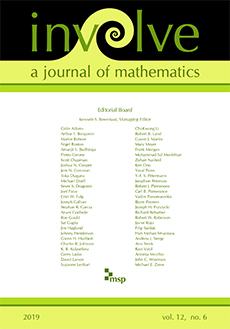Abstract
The notion of a -agreeable society was introduced by Berg, Norine, Su, Thomas and Wollan: a family of convex subsets of is called -agreeable if any subfamily of size contains at least one nonempty -fold intersection. In that paper, the -agreeability of a convex family was shown to imply the existence of a subfamily of size with a nonempty intersection, where is the size of the original family and is an explicit constant depending only on , and . The quantity is called the minimal agreement proportion for a -agreeable family in .
If we assume only that the sets are convex, simple examples show that for -agreeable families in where . In this paper, we introduce new techniques to find positive lower bounds when restricting our attention to families of -boxes, that is, cuboids with sides parallel to the coordinates hyperplanes. We derive explicit formulas for the first nontrivial case: -agreeable families of -boxes with .
Citation
Michael Abrahams. Meg Lippincott. Thierry Zell. "On $(2,3)$-agreeable box societies." Involve 3 (1) 93 - 108, 2010. https://doi.org/10.2140/involve.2010.3.93
Information





